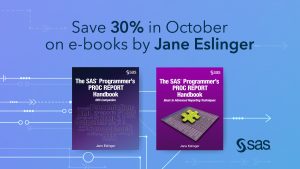We publish a lot of books by SAS experts at SAS Press, but how does someone become an expert in the first place? Becoming certified is one step, but who develops the certifications in the first place? Those are the true experts. They have to have a deep understanding of SAS, an ability to explain difficult concepts, and a passion for sharing their knowledge. Our SAS Press Author of the Month for October is Jane Eslinger, also known around the office as the PROC REPORT expert.
Jane has written two books on PROC REPORT that are the go-to reference for anyone who wants to understand all of the capabilities of the REPORT procedure. I asked her a few questions about how she became the PROC REPORT expert and what advice she has for SAS novices.
Q: What made you decide to write a book about PROC REPORT?
At the time I was in SAS Technical Support and answering customer questions on PROC REPORT. I tell people that PROC REPORT has a large learning curve. I knew PROC REPORT but discovered that information about it was spread across a wide variety of places – SAS notes, conference papers, and SAS Communities posts. I decided that I wanted to put all of the information in one place, so I wrote the first book.
Q: Have you noticed any new trends in reporting in the last few years?
Good question. I would say that programmers are more interested in making drill-down or cascading reports. People want to click from one report to the next, more refined report.
Q: What do you think is the most misunderstood feature of PROC REPORT?
Two things, actually. First, is the compute block. Programmers know that they can assign or change values within the compute block. They also know it can be used to affect styling. But it takes practice to get all of it right. And lots of programmers use compute blocks for the bare essentials but it can do so much more.
Second, is the COLUMN statement. Programmers want to control what is in the header section of the report but do not understand how do use spanning headers and null headers to get what they want.
Q: How did you first learn SAS?
I had to use it in my regression statistics course in college, as well as take a basic programming class for my degree.
Q: As an instructor, how do you encourage students who get frustrated when learning SAS?
I tell them that they are learning a new language or a new skill. You aren’t going to get it right the first time! I also tell them that programmers with 20 years of experience still have to look up syntax.
Q: What is your best advice for someone who wants to learn SAS?
Practice. But really the best way to practice is to have a project (school or at work) that requires you to use SAS. Learning SAS is much easier when you can connect programming concepts to your own project instead of arbitrary data.
Q: Just for fun, what is the last non-technical book you read that you enjoyed?
Wish You Were Here by Jodi Picoult.
 Thanks for talking to me, Jane! Visit Jane’s author page to find an exclusive discount code that you can use to purchase her e-books in the month of October.
Thanks for talking to me, Jane! Visit Jane’s author page to find an exclusive discount code that you can use to purchase her e-books in the month of October.
You can also find her at SESUG 2022 where she will be giving a hands-on training session on how to create PROC REPORT code for multiple report types. And check out Jane's "Ask the Expert" webinars anytime to learn more about PROC REPORT:
- Ask the Expert | PROC REPORT: Getting Started
- Ask the Expert | PROC Report: Next Steps
- Ask the Expert | When Should I Use Dummy Variables with PROC REPORT?
